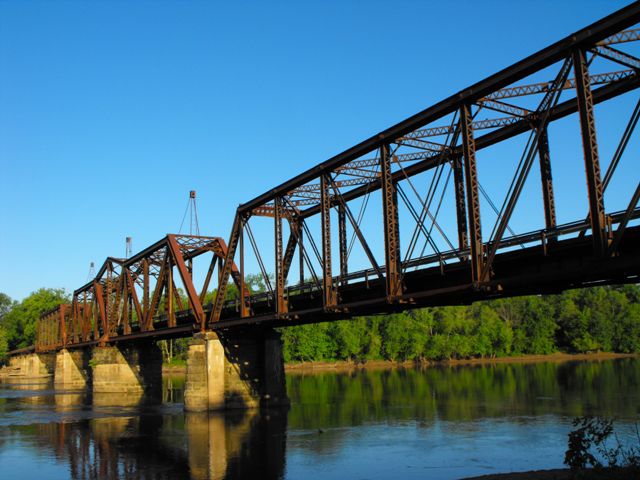We Recommend:
Bach Steel - Experts at historic truss bridge restoration.
Wabash Cannonball Bridge
Stangle Bridge, Purple Head Bridge

Primary Photographer(s): Nathan Holth and Rick McOmber
Bridge Documented: May 9, 2010
St. Francisville: Lawrence County, Illinois and Knox County, Indiana: United States
Metal Rivet-Connected Warren Through Truss, Movable: Swing (Center Pier) and Approach Spans: Metal Pin-Connected Pratt Through Truss, Fixed
1897 By Builder/Contractor: Edge Moor Bridge Works of Wilmington, Delaware and King Bridge Company of Cleveland, Ohio
1924
235.0 Feet (71.6 Meters)
1,441.0 Feet (439.2 Meters)
Not Available
1 Main Span(s) and 16 Approach Span(s)
Not Applicable

View Information About HSR Ratings
Bridge Documentation
This bridge is a most unusual historic bridge, both because this large, multi-span structure is composed of spans from three different dates and also because of its conversion for vehicular traffic. Originally a railroad bridge, the railroad company did not engage in wholesale demolition and replacement of the bridge at any given time, but rather replaced individual spans as needed. As such, spans on the bridge date from 1897, 1904, and 1924. Later in the 20th Century, the bridge was abandoned by the railroad. The bridge did then at a later date find new life in an uncommon way: a farmer named Frank Stangle bought the bridge in 1970 and opened it for vehicular traffic as a toll bridge. What is interesting is very minimal changes were made to the bridge by this private owner. The railroad ties were left in place, and running planks for cars were simply put in place. The rails were removed from the deck, but did not leave the bridge, since the guardrail that was added to the bridge uses the railroad rails as guardrail posts. In 1995, the bridge apparently was sold to the city of St. Francisville. In the 21st Century, the bridge was sold to the State of Illinois in 2009 who claims they will maintain the bridge and keep it open. However, given the striking lack of historic bridge preservation in Illinois, especially with IDOT owned bridges, from other Wabash River Bridges such as the Mt. Carmel Bridge (for which IDOT was lead agency), to the Seneca Bridge, some concern and uncertainty for the future of this bridge due to this transfer of ownership seems warranted. It is hoped this bridge will receive a higher level of care and attention than those bridges, given its historic significance.
From east (Indiana) to west (Illinois), the bridge is composed of spans as follows. First, there are five deck plate girder spans built in 1904 by King Bridge Company of Cleveland, Ohio. Each span has a plaque mounted on it. It was noted that not all spans have 1904 on the plaque; one of the spans lists 1903. Perhaps these spans were pre-fabricated standard-size spans by King Bridge Company in 1903 and were something they still had on-hand and sold to the railroad in 1904. Next, the easternmost truss span, a fixed, riveted through truss span of 157 feet and six panels, which likely dates to 1924 when the swing span was also built. Working westward, there is a fixed pin-connected through truss span, dating to 1897 built by Edge Moor Bridge Works of Wilmington, Delaware containing eight panels. Next, is an eight panel 235 foot 1924 swing through truss span with riveted connections. This is followed by another eight panel 1897 Edge More Bridge Works span, and concluded by eight more 1904 King Bridge Company deck plate girder spans.
Driving across this bridge is a rare opportunity in North America to experience crossing a bridge that is in excess of 1000 feet yet is only one lane. Other than having to carefully look to check and make sure that any traffic seen at the other end has begun to cross the bridge, crossing this bridge can be a very fun experience. The bridge should also be assigned a high level of historic significance for being associated with multiple noteworthy bridge builders, as well as for its unique variety of spans. This variety of spans clearly shows the different approach railroad companies took to bridge maintenance and replacement verus the zero sum game that highway agencies more frequently play, where it is either replace the entire bridge or defer even routine maintenance. The difference is because railroad companies seek to make a profit, and prefer to spend the least amount of money on bridges long-term which translates to focusing on maintenance, repairs, and only partial bridge replacement when needed. The model serves as a good example for highway agencies to follow, should they wish to spend their funds... tax dollars... in a more fiscally responsible manner.
Wabash Cannonball Bridge is a common name for the bridge. Stangle Bridge refers to the farmer who bought the bridge and first converted it for vehicular use. Purple Head Bridge relates to local lore that claims this bridge is haunted. The bridge is sometimes also called the St. Francisville Bridge referring to the small Illinois community it connects to.
Information and Findings From DHPA Historic Bridge SurveyStatement of Significance This structure is an extraordinary collection of design and fabrication from a key thirty-five-year span of railroad building . The design of each kind of span reveals some unusual features. There are, furthermore, few swing spans left in Indiana. Together they also represent many important out-of-state builders. The structure remains intact, including its many differently-decorated portals. Architectural Description As they currently stand, the seventeen metal spans
of the Stangle Bridge represent several eras of railroad design and
construction. Now abandoned, the structure once carried a single track
of the Big Four Railroad. Bibliography Engineering News-Record, 22 June 1916, v. 75, Construction News, p. 478, 31 July 1924, v. 93, p. 60. Bridge Considered Historic By Survey: Yes |
![]()
Photo Galleries and Videos: Wabash Cannonball Bridge
Bridge Photo-Documentation
Original / Full Size PhotosA collection of overview and detail photos. This gallery offers photos in the highest available resolution and file size in a touch-friendly popup viewer.
Alternatively, Browse Without Using Viewer
![]()
Bridge Photo-Documentation
Mobile Optimized PhotosA collection of overview and detail photos. This gallery features data-friendly, fast-loading photos in a touch-friendly popup viewer.
Alternatively, Browse Without Using Viewer
![]()
Crossing From Indiana To Illinois
Full Motion VideoStreaming video of the bridge. Also includes a higher quality downloadable video for greater clarity or offline viewing.
![]()
Maps and Links: Wabash Cannonball Bridge
Coordinates (Latitude, Longitude):
Search For Additional Bridge Listings:
Bridgehunter.com: View listed bridges within 0.5 miles (0.8 kilometers) of this bridge.
Bridgehunter.com: View listed bridges within 10 miles (16 kilometers) of this bridge.
Additional Maps:
Google Streetview (If Available)
GeoHack (Additional Links and Coordinates)
Apple Maps (Via DuckDuckGo Search)
Apple Maps (Apple devices only)
Android: Open Location In Your Map or GPS App
Flickr Gallery (Find Nearby Photos)
Wikimedia Commons (Find Nearby Photos)
Directions Via Sygic For Android
Directions Via Sygic For iOS and Android Dolphin Browser
USGS National Map (United States Only)
Historical USGS Topo Maps (United States Only)
Historic Aerials (United States Only)
CalTopo Maps (United States Only)




